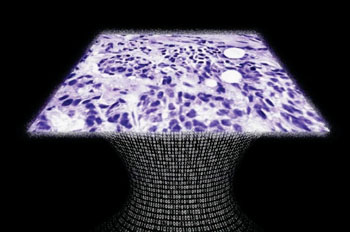Lens-Free Microscope Creates Images from Pathology Slides
By LabMedica International staff writers
Posted on 01 Jan 2015
A lens-free microscope has been developed that can be used to detect the presence of cancer or other cell-level abnormalities with the same accuracy as larger and more expensive optical microscopes. Posted on 01 Jan 2015
The system could lead to less expensive and more portable technology for performing common examinations of tissue, blood and other biomedical specimens and it may prove especially useful in remote areas and in cases where large numbers of samples need to be examined quickly.

Image: A tissue sample image created by the new lens-free microscope (Photo courtesy of Prof. Aydogan Ozcan).
Scientists at the University of California, Los Angeles (UCLA; USA) developed the device which works by using a laser or light-emitting-diode to illuminate a tissue or blood sample that has been placed on a slide and inserted into the device. A sensor array on a microchip, the same type of chip that is used in digital cameras, including cellphone cameras, captures and records the pattern of shadows created by the sample.
The device processes these patterns as a series of holograms, forming three-dimensional (3-D) images of the specimen and giving medical personnel a virtual depth-of-field view. An algorithm color codes the reconstructed images, making the contrasts in the samples more apparent than they would be in the holograms and making any abnormalities easier to detect.
The team tested the device using Papanicolaou (Pap) smears that indicated cervical cancer, tissue specimens containing cancerous breast cells, and blood samples containing sickle cell anemia. In a blind test, a board-certified pathologist analyzed sets of specimen images that had been created by the lens-free technology and by conventional microscopes. The pathologist's diagnoses using the lens-free microscopic images proved accurate 99% of the time. Another benefit of the lens-free device is that it produces images that are several hundred times larger in area, or field of view, than those captured by conventional bright-field optical microscopes, which makes it possible to process specimens more quickly.
Aydogan Ozcan, PhD, the Chancellor's professor of electrical engineering and bioengineering and senior author of the study said, “While mobile health care has expanded rapidly with the growth of consumer electronics, cellphones in particular, pathology is still, by and large, constrained to advanced clinical laboratory settings. Accompanied by advances in its graphical user interface, this platform could scale up for use in clinical, biomedical, scientific, educational and citizen-science applications, among others.” The study was published on December 17, 2014, in the journal Science Translational Medicine.
Related Links:
University of California, Los Angeles













